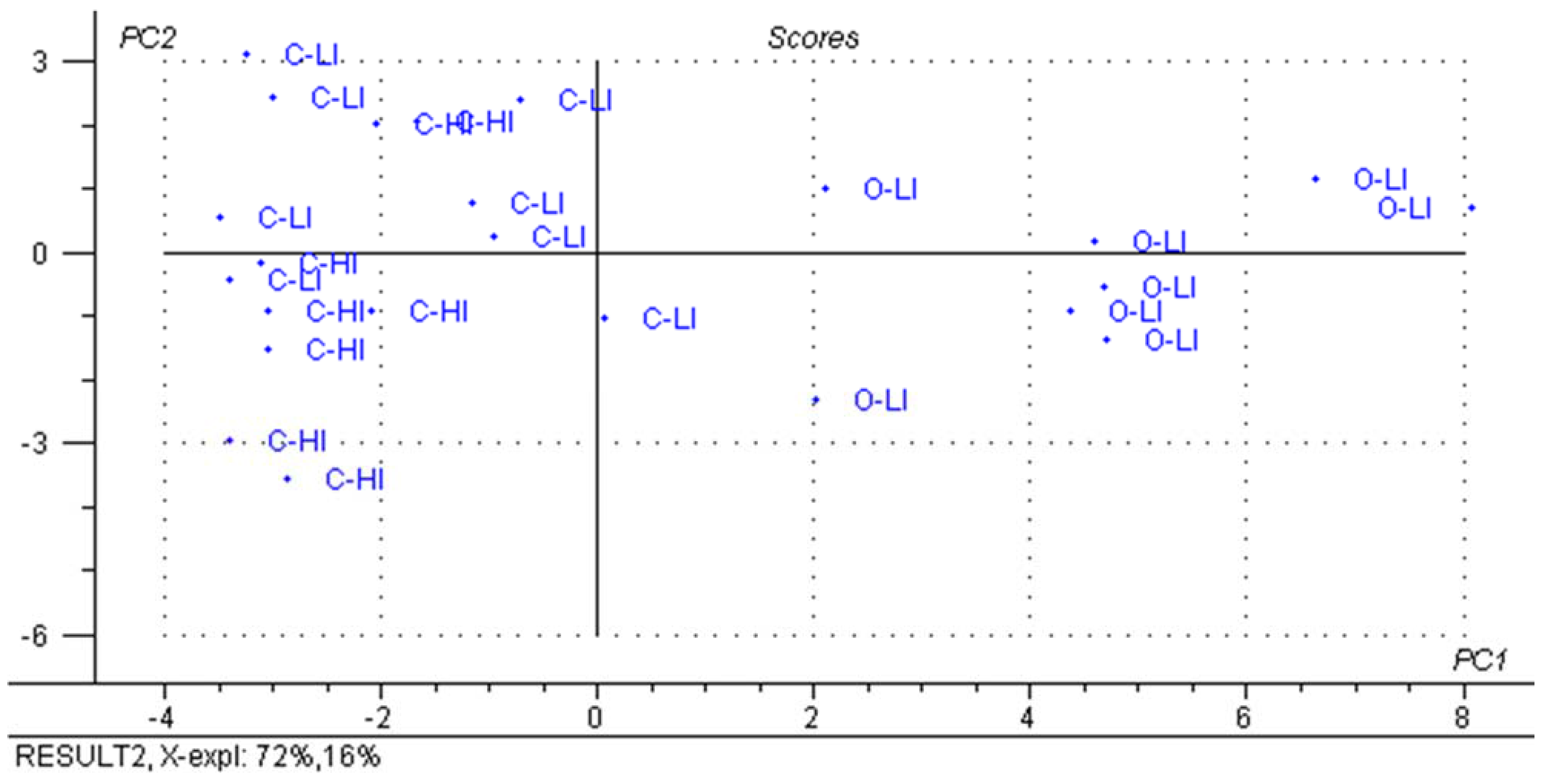Farm Management in Organic and Conventional Dairy Production Systems Based on Pasture in Southern Brazil and Its Consequences on Production and Milk Quality
Abstract
:Simple Summary
Abstract
1. Introduction
2. Materials and Methods
3. Results and Discussion
3.1. Farm Characteristics
| Items | Management Types | |||
|---|---|---|---|---|
| C-HI | C-LI | O-LI | SEM | |
| Total farm area (ha) | 28.9 a | 21.4 a,b | 18.6 b | 1.75 |
| Area of perennial pasture (%) | 18.8 b | 23.7 b | 52.3 a | 5.98 |
| Area of annual pasture (%) | 38.7 a | 38.1 a | 12.9 b | 4.97 |
| Other (building, crops, subsistence and legal reserve area) (%) | 42.5 | 38.2 | 34.4 | 8.89 |
| Breed of lactating cows (%) | ||||
| Holstein | 50.6 | 33.4 | 20.8 | 3.42 |
| Jersey | 13.0 | 20.8 | 20.1 | 1.40 |
| Holstein Jersey crossbred | 36.4 | 45.8 | 59.1 | 2.99 |
| Number of lactating animals | 26.3 a | 19.1 b | 13.1 c | 1.79 |
| Number of lactating cows/ha | 1.9 a | 1.4 a,b | 1.2 b | 0.15 |
3.2. Diet Composition, Production and Milk Quality
| Diet Composition | Season | Management Types | ||||
|---|---|---|---|---|---|---|
| * (kg DM/cow/day) | C-HI | C-LI | O-LI | SDM | ||
| Concentrate | ||||||
| Autumn | 3.83 | 1.73 | 0 | 2.00 | ||
| Winter | 3.65 | 1.46 | 0.20 | 1.64 | ||
| Spring | 3.32 | 1.55 | 0.10 | 1.48 | ||
| Summer | 3.20 | 1.87 | 0 | 1.44 | ||
| Silage | ||||||
| Autumn | 8.31 | 5.38 | 0 | 3.91 | ||
| Winter | 7.66 | 5.37 | 1.30 | 3.43 | ||
| Spring | 7.04 | 3.50 | 0.20 | 3.32 | ||
| Summer | 6.33 | 6.33 | 0 | 3.57 | ||
| Parameters | Season | Management Types | |||
|---|---|---|---|---|---|
| CH-I | CL-I | O-LI | SEM | ||
| Milk yield (kg/lactating cow/day) corrected fat 4% | Autumn | 23.1 ABa | 16.8 b | 9.2 c | 1.45 |
| Winter | 22.1 Ba | 18.0 ab | 10.8 c | 1.45 | |
| Spring | 25.8 Aa | 19.2 ab | 9.8 c | 1.45 | |
| Summer | 22.8 ABa | 19.3 ab | 10.2 c | 1.45 | |
| Fat (%) | Autumn | 4.4 Aa | 4.1 Aa | 4.4 Ba | 0.20 |
| Winter | 4.0 ABa | 3.9 Aa | 4.8 Ab | 0.21 | |
| Spring | 4.5 Aa | 4.2 Aa | 4.0 Ba | 0.22 | |
| Summer | 3.9 Ba | 4.1 Aa | 4.1 Ba | 0.15 | |
| Protein (%) | Autumn | 3.4 | 3.2 | 3.3 | 0.10 |
| Winter | 3.7 | 3.3 | 3.3 | 0.25 | |
| Spring | 3.2 | 3.3 | 3.2 | 0.07 | |
| Summer | 3.1 | 3.3 | 3.1 | 0.06 | |
| Lactose (%) | Autumn | 4.3 | 4.3 | 4.3 | 0.09 |
| Winter | 4.5 | 4.4 | 4.4 | 0.07 | |
| Spring | 4.5 | 4.4 | 4.6 | 0.05 | |
| Summer | 4.4 | 4.4 | 4.6 | 0.07 | |
| Total Solids (%) | Autumn | 13.1 Aa | 12.6 Aa | 12.9 Aa | 0.26 |
| Winter | 11.9 Ba | 11.8 Ba | 12.6 Ab | 0.21 | |
| Spring | 13.2 Aa | 12.9 Aa | 12.7 Aa | 0.21 | |
| Summer | 12.3 Ba | 12.6 Aa | 12.5 Aa | 0.18 | |
| Season | Management Types | Plant Species | ||
|---|---|---|---|---|
| Cultivated Grass | Legume | Native Forage | ||
| Autumn | C-HI | Avena sativa; | Urochloa plantaginea | |
| Eleusine indica; | ||||
| Sorghum sudanensis | ||||
| C-LI | Avena sativa; Avena strigosa; Lolium multiflorum; Sorghum sudanensis | Cynodon dactylon | ||
| O-LI | Axonopus affinis; Axonopus campressus; Lolium multiflorum; Saccharum officinarum; Pennisetum purpureum | Trifolium repens | Ageratum conyzoides; Amaranthus deflexus; Amaranthus spinosus; Kylling abrevifolia; Paspalum mandiocanum; Paspalum umbrosum; Paspalum urvillei; Plantago australis; Solidago chilensis | |
| Winter | C-HI | Avena strigosa; Lolium multiflorum | ||
| C-LI | Avena strigosa; Lolium multiflorum | |||
| O-LI | Avena strigosa; Lolium multiflorum | Trifolium repens | Bowlesia incana; Bromus catharticus; Cerastium glomeratum; Hypochaeris megapotamica; Hypochaeris sp.; Paspalum umbrosum; Plantago australis; Veronica arvensis | |
| Spring | C-HI | Avena sativa; Lolium multiflorum | ||
| C-LI | Avena sativa; Lolium multiflorum | |||
| O-LI | Avena strigosa; Lolium multiflorum | Trifolium repens; Vicia sativa | Cynodon defensis; Leonurus sibiricus; Paspalum urvillei; Penisetum setaceum; Plantago australis | |
| Summer | C-HI | Pennisetum americanum; Sorghum sudanensis | ||
| C-LI | Pennisetum americanum; Sorghum sudanensis | |||
| O-LI | Pennisetum purpureum; Sorghum sudanensis | Desmodium affine; Glicine max | Digitaria ciliaris; Euphorbia heterophylla; Paspalum juergensii; Paspalum umbrosum; Urochloa plantaginea | |
| Season | Management Types | BMBC (×1000 CFU/mL) | SEM | BTSCC (×1000 cells/mL) | SEM |
|---|---|---|---|---|---|
| Autumn | C-HI | 1226 | 724.4 | 775 | 231.7 |
| C-LI | 1408 | 724.4 | 545 | 231.7 | |
| O-LI | 1472 | 724.4 | 609 | 231.7 | |
| Winter | C-HI | 223 | 958.4 | 498 | 113.4 |
| C-LI | 2174 | 958.4 | 469 | 113.4 | |
| O-LI | 498 | 958.4 | 350 | 113.4 | |
| Spring | C-HI | 418 | 197.4 | 301 | 85.6 |
| C-LI | 475 | 197.4 | 575 | 85.6 | |
| O-LI | 801 | 197.4 | 297 | 85.6 | |
| Summer | C-HI | 444 | 131.6 | 353 | 97.4 |
| C-LI | 557 | 131.6 | 467 | 97.4 | |
| O-LI | 393 | 131.6 | 308 | 97.4 |


4. Conclusions
Acknowledgments
Author Contributions
Conflicts of Interest
References
- FAO. Food and Agriculture Organization of the United Nations—Statistics Division. 2012. Available online: http://faostat.fao.org/site/339/default.aspx (accessed on 20 January 2015).
- Fischer, A.; Santos Junior, S.; Sehnem, S.; Bernardi, I. Produção e produtividade de leite do oeste catarinense. RACE-Revista de Administração, Contabilidade e Economia 2012, 10, 337–362. (in Portuguese). [Google Scholar]
- ICEPA. Sintese Anual da Agricultura de Santa Catarina. 2009. Available online: http://www.cepa.epagri.sc.gov.br/Publicacoes/SINTESE2001.PDF (accessed on 15 July 2014). (in Portuguese) [Google Scholar]
- Costa, J.H.C.; Hötzel, M.J.; Longo, C.; Balcão, L.F. A survey of management practices that influence production and welfare of dairy cattle on family farms in southern Brazil. J. Dairy Sci. 2013, 96, 307–317. [Google Scholar] [CrossRef] [PubMed]
- European Commission. Organic Farming. Available online: http://ec.europa.eu/agriculture/organic/organic-farming (accessed on 21 August 2013).
- WHO. Global Burden of Disease in 2002: Data Sources, Methods and Results; WHO: Geneva, Switzerland, 2003; p. 181. [Google Scholar]
- Honorato, L.A.; Machado Filho, L.C.P.; Barbosa Silveira, I.D.; Hötzel, M.J. Strategies used by dairy family farmers in the south of Brazil to comply with organic regulations. J. Dairy Sci. 2014, 97, 1319–1327. [Google Scholar] [CrossRef] [PubMed]
- Basset-Mens, C.; Ledgard, S.; Boyes, M. Eco-efficiency of intensification scenarios for milk production in New Zealand. J. Ecol. Econ. 2009, 68, 1615–1625. [Google Scholar] [CrossRef]
- Thomassen, M.A.; Van Calker, K.J.; Smits, M.C.J.; Iepema, G.L.; De Boer, I.J.M. Life cycle assessment of conventional and organic milk production in the Netherlands. Agric. Syst. 2008, 96, 95–107. [Google Scholar] [CrossRef]
- Butler, G.; Nielsen, J.H.; Slots, T.; Seal, C.; Eyre, M.D.; Sanderson, R.; Leifert, C. Fatty acid and fat-soluble antioxidant concentrations in milk from high- and low-input conventional and organic systems: Seasonal variation. J. Sci. Food Agric. 2008, 88, 1431–1441. [Google Scholar] [CrossRef]
- Slots, T.; Butler, G.; Leifert, C.; Kristensen, T.; Skibsted, L.H.; Nielsen, J.H. Potentials to differentiate milk composition by different feeding strategies. J. Dairy Sci. 2009, 92, 2057–2066. [Google Scholar] [CrossRef] [PubMed]
- Stiglbauer, K.E.; Cicconi-Hogan, K.M.; Richert, R.; Schukken, Y.H.; Ruegg, P.L.; Gamroth, M. Assessment of herd management on organic and conventional dairy farms in the United States. J. Dairy Sci. 2013, 96, 1290–1300. [Google Scholar] [CrossRef] [PubMed]
- Adler, S.; Jensen, S.K.; Govasmark, E.; Steinshamn, H. Effect of short-term versus long-term grassland management and seasonal variation in organic and conventional dairy farming on the composition of bulk tank milk. J. Dairy Sci. 2013, 96, 5793–5810. [Google Scholar] [CrossRef] [PubMed] [Green Version]
- Pulido, R.G.; Muñoz, R.; Lemarie, P.; Wittwer, F.; Orellana, P.; Waghorn, G.C. Impact of increasing grain feeding frequency on production of dairy cows grazing pasture. Livest. Sci. 2009, 125, 109–114. [Google Scholar] [CrossRef]
- Soder, K.J.; Rotz, C.A. Impact of Utilizing a Total Mixed Ration in Pennsylvania Grazing Dairy Herds; USDA/Agricultural Research Service, Pasture Systems and Watershed Management Research Unit: University Park, PA, USA, 2007. [Google Scholar]
- Balcão, F.L. Tipologia da atividade leiteira na região Noroeste de Santa Catarina. Master Degree, Universidade Federal de Santa Catarina, Florianópolis, Brazil, 2012. [Google Scholar]
- Brasil. Lei n.10.831, de 23 de dezembro de 2003. Dispõe sobre a agricultura orgânica. IBD Certificações. Diretrizes e Legislação. Decreto da Lei 10.831 de Produtos Orgânicos. Available online: http://www.ibd.com.br/Downloads/DirLeg/Legislacao/05- Lei_10831_2003.pdf (accessed on 13 September 2014).
- Alvares, C.A.; Stape, J.L.; Sentelhas, P.C.; de Moraes Gonçalves, J.L.; Sparovek, G. Köppen’s climate classification map for Brazil. Meteorologische Zeitschrift 2014, 22, 711–728. [Google Scholar]
- Van Soest, P.J.; Goering, H.K. Forage Fiber Analysis: Apparatus, Reagents, Procedures and Some Applications; Agriculture Research Service, United States Department of Agriculture: Washington, DC, USA, 1970; pp. 1–20. [Google Scholar]
- Euclides, V.P.B.; Macedo, M.C.M.; Oliveira, M.P. Avaliação de diferentes métodos de amostragens sob pastejo. R. Bras. Zootec. 1992, 21, 691–702. [Google Scholar]
- IDF. International IDF Standard; 141C; IDF: Brussels, Belgium, 2000. [Google Scholar]
- IDF. International IDF Standard; 196; IDF: Brussels, Belgium, 2004. [Google Scholar]
- IDF. International IDF Standard; 148-2; IDF: Brussels, Belgium, 2006. [Google Scholar]
- Brasil. Instrução normativa n.46, de 6 de outubro de 2011. Ministério da Agricultura, Pecuária e Abastecimento, 2011. Available online: http://www.aao.org.br/aao/pdfs/legislacao-dos.../instrucao-normativa-n46.pdf (accessed on 21 August 2013).
- Clive, J. Global Status of Commercialized Biotech/GM Crops: 2013; ISAAA Brief N° 46. ISAAA: Ithaca, NY, USA, 2013. Available online: http://www.isaaa.org/resources/publications/briefs/46/executivesummary/ (accessed on 9 April 2015).
- Voisin, A. Produtividade do Pasto; Mestre Jou: São Paulo, Brazil, 1974; p. 520. [Google Scholar]
- Machado, L.C.P. Pastoreio Racional Voisin; Cinco Continentes: Porto Alegre, Brazil, 2004. [Google Scholar]
- Hart, R.H.; Bissio, J.; Samuel, M.J.; Waggoner, J.W., Jr. Grazing systems, pasture size, and cattle grazing behavior and gains. J. Range Manag. 1993, 46, 81–87. [Google Scholar] [CrossRef]
- Abrahamse, P.A.; Dijkstra, J.; Vlaeminck, B.; Tamminga, S. Frequent allocation of rotationally grazed dairy cows changes grazing behavior and improves productivity. J. Dairy Sci. 2008, 91, 2033–2045. [Google Scholar] [CrossRef] [PubMed]
- Pavlu, V.; Hejcmanb, M.; Gaisler, J.; Nezerková, P. Effect of continuous grazing on forage quality, quantity and animal performance. Agric. Ecosyst. Environ. 2006, 113, 349–355. [Google Scholar] [CrossRef]
- Tilman, D.; Reich, P.B.; Knops, J.; Wedin, D.; Mielke, T.; Lehman, C. Diversity and Productivity in a Long-Term Grassland Experiment. Science 2001, 294, 843–845. [Google Scholar] [CrossRef] [PubMed]
- Finlayson, J.D.; Lawes, R.A.; Metcalf, T.; Robertson, M.J.; Ferris, D.; Ewing, M.A. A bio-economic evaluation of the profitability of adopting subtropical grasses and pasture-cropping on crop-livestock farms. Agric. Syst. 2012, 106, 102–112. [Google Scholar] [CrossRef]
- Sanderson, M.A. Stability of production and plant species diversity in managed grasslands: A retrospective study. Basic Appl. Ecol. 2010, 11, 216–224. [Google Scholar] [CrossRef]
- Sanderson, M.A.; Corson, M.S.; Rotz, C.A.; Soder, K.J. Economic Analysis of Forage Mixture Productivity in Pastures Grazed by Dairy Cattle. Online. Forage Grazinglands 2006, 4. Available online: https://www.crops.org/publications/fg/abstracts/4/1/2006-0929-01-RS?access=0&view=article (accessed on 13 July 2013). [Google Scholar] [CrossRef]
- Nauta, W.J.; Baars, T.; Saatkamp, H.; Weenink, D.; Roep, D. Farming strategies in organic dairy farming: Effects on breeding goal and choice of breed. An explorative study. Livest. Sci. 2009, 121, 187–199. [Google Scholar] [CrossRef]
- Clark, D.A.; Caradus, J.R.; Monaghan, R.M.; Sharp, P.; Thorrold, B.S. Issues and options for future dairy farming in New Zealand. N. Zeal. J. Agric. Res. 2007, 50, 203–221. [Google Scholar] [CrossRef]
- Fredeen, A.H. Considerations in the nutritional modification of milk composition. Anim. Feed Sci. Technol. 1996, 59, 185–197. [Google Scholar] [CrossRef]
- Teixeira, N.M.; Freitas, A.F.; Barra, R.B. Influência de fatores de meio ambiente na variação mensal da composição e contagem de células somáticas do leite em rebanhos no estado de Minas Gerais. Arq. Bras. Med. Vet. Zootec. 2003, 55, 491–499. [Google Scholar] [CrossRef]
- Lopes, F.C.F.; Aroeira, L.J.M.; Rodriguez, N.M.; Deresz, F.; Sampaio, I.B.M.; Paciullo, D.S.C.; Vittori, A. Efeito da suplementação e do intervalo de pastejo sobre a qualidade da forragem e consumo voluntário de vacas Holandês x Zebu em lactação em pastagem de capim elefante. Arq. Bras. Med. Vet. Zootec. 2004, 56, 355–362. [Google Scholar] [CrossRef]
- Aroeira, L.J.M.; Lopes, F.C.F.; Deresz, F.; Verneque, R.S.; Dayrell, M.S.; De Matos, L.L.; Maldonado-Vasquez, H.; Vittori, A. Pasture availability and dry matter intake of lactating crossbred cows grazing elephant grass (Pennisetum purpureum, Schum.). Anim. Feed Sci. Technol. 1999, 78, 313–324. [Google Scholar] [CrossRef]
- Law, B.A.; Tamime, A.Y. Technology of Cheesemaking, 2nd ed.; Wiley-Brackwell Publishing: Ames, IA, USA, 2010. [Google Scholar]
- Bueno, V.F.F.; De Mesquita, A.J.; de Oliveira, A.N.; Nicolau, E.S.; Neves, R.B.S. Contagem bacteriana total do leite: Relação com a composição centesimal e período do ano no Estado de Goiás. Revista Brasileira de Ciência Veterinária 2008, 15, 40–44. [Google Scholar] [CrossRef]
- APHIS. Determining U.S. Milk Quality Using Bulk-tank Somatic Cell Counts. Veterinary Services, Centers for Epidemiology and Animal Health, 2012. Available online: http://usdasearch.usda.gov/search?utf8=%3F&affiliate=usdaaphis&query=somatic+cell&commit=Search (accessed on 17 March 2015). [Google Scholar]
- NCIMS—National Conference on Interstate Milk Shipments. Actions of the 2011 National Conference on Interstate Milk Shipments. Available online: http://www.ncims.org/ (accessed on 28 May 2013).
- Larsen, M.K.; Nielsen, J.H.; Butler, G.; Leifert, C.; Slots, T.; Kristiansen, G.H.; Gustafsson, A.H. Milk quality as affected by feeding regimens in a country with climatic variation. J. Dairy Sci. 2010, 93, 2863–2873. [Google Scholar] [CrossRef] [PubMed]
- Culman, S.W.; Dupont, S.T.; Glover, J.D.; Buckley, D.H.; Fick, G.W.; Ferris, H.; Crews, T.E. Long-term impacts of high-input annual cropping and unfertilized perennial grass production on soil properties and belowground food webs in Kansas, USA. Agric. Ecosyst. Environ. 2010, 137, 13–24. [Google Scholar] [CrossRef]
- Glover, J.D.; Culman, S.W.; Dupont, S.T.; Broussard, W.; Young, L.; Mangan, M.E.; Mai, J.G.; Crews, T.E.; Dehaan, L.R.; Buckley, D.H.; et al. Harvested perennial grasslands provide ecological benchmarks for agricultural sustainability. Agric. Ecosyst. Environ. 2010, 137, 3–12. [Google Scholar] [CrossRef]
© 2015 by the authors; licensee MDPI, Basel, Switzerland. This article is an open access article distributed under the terms and conditions of the Creative Commons Attribution license (http://creativecommons.org/licenses/by/4.0/).
Share and Cite
Kuhnen, S.; Stibuski, R.B.; Honorato, L.A.; Filho, L.C.P.M. Farm Management in Organic and Conventional Dairy Production Systems Based on Pasture in Southern Brazil and Its Consequences on Production and Milk Quality. Animals 2015, 5, 479-494. https://doi.org/10.3390/ani5030367
Kuhnen S, Stibuski RB, Honorato LA, Filho LCPM. Farm Management in Organic and Conventional Dairy Production Systems Based on Pasture in Southern Brazil and Its Consequences on Production and Milk Quality. Animals. 2015; 5(3):479-494. https://doi.org/10.3390/ani5030367
Chicago/Turabian StyleKuhnen, Shirley, Rudinei Butka Stibuski, Luciana Aparecida Honorato, and Luiz Carlos Pinheiro Machado Filho. 2015. "Farm Management in Organic and Conventional Dairy Production Systems Based on Pasture in Southern Brazil and Its Consequences on Production and Milk Quality" Animals 5, no. 3: 479-494. https://doi.org/10.3390/ani5030367





